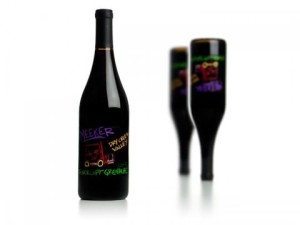 In the last couple of days, we’ve had the pleasure of offering two more wines on Woot – the 2007 Grenache and the 2006 Carignane. The Woot readers asked for a description of the Grenache, and Luke graciously complied:
In the last couple of days, we’ve had the pleasure of offering two more wines on Woot – the 2007 Grenache and the 2006 Carignane. The Woot readers asked for a description of the Grenache, and Luke graciously complied:
Anyways, this 2007 Grenache (which we lovingly call Forklift!) is an awesome awesome awesome wine. This is probably in my top 5 favorite wines that we’ve released in the past 5 years or so. Here’s why…
Grenache, as you all probably know, is a varietal that can make a variety of different styles of wine. Some light and fruity, some dark and inky. This is not only because of massive variance in just plain old winemaking style, but also because the different vine clones that we have available to us can vary greatly in color and tannin production.
Now that most of you are relatively familiar with our style of wine (big structure, tannic, medium alcohol, long aging, high acidity, etc.), you can probably assume that a Meeker Grenache is not going to be your typical Grenache… and you’d be correct.
If you all remember, one of the techniques that we use when we ferment Cabernet Franc to avoid green-ness and maximize fruit extraction is to do a “bleed”, where we drain a certain amount of juice off of the must before fermentation in order to increase the skin-to-juice ratio. The point of this is simple: the tannin, color, flavor, everything delicious, the “good stuff”, in a finished red wine largely comes from the skins and seeds of the grape. If you decrease the amount of initial juice, but leave the original amount of skins and seeds, you have a smaller quantity of wine that all the same amount of “good stuff” goes into.
In grapes that don’t inherently produce massive amount of fruit forward character and big tannin development, juice bleeding is a very effective tool. In that wonderful Cab Franc we had on Woot a couple months ago, we did a 20% juice bleed. That’s a pretty heavy bleed, but well within industry standards.
This Grenache, however… 50% juice bleed. Seriously. We drained off 50% of the juice into our rose blend. We absolutely went bat-feces crazy on the bleed in order to maximize color, structure, fruit and character.
Kaboom. It worked.
This wine is awesome.
You all are probably familiar with Grenache’s role in Rhone blends and the like, and there are lots of great things to say about those wines. Hopefully, however, you’ve had the pleasure of seeing what this grape does in Dry Creek Valley. If you have, you probably liked it. If you haven’t, this is a heck of an opportunity to get your foot in the door.
I will say this, though: Whereas the Carignane we had up yesterday is pretty much the only “medium” bodied wine we make… this Grenache is NOT, by any means, a medium bodied wine. Even though the varietal’s general character and typical style would lead you to believe this is a light, fruity wine, don’t be fooled. This is Grenache with guts.
I think I’m going to trademark that last line.
Unfortunately, because I’m at home right now and not at work (you can thank my Dad for actually letting me go home), I don’t have any of that wonderful technical data that I would normally throw at you all. Hopefully you can do without it. As you know, we correct all of our wines to .75 TA, so that number I can definitely give you: this wine started fermentation at .75 TA. Past that, you’ll have to just trust me: this wine rules.
You can expect it to cellar for at least another 3-5 years. Maybe longer. You won’t, though. You’ll open one bottle and the other two will be gone within a month. And you probably won’t want to share with your friends that aren’t that important to you. Just saying.
